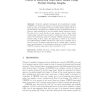Free Online Productivity Tools
i2Speak
i2Symbol
i2OCR
iTex2Img
iWeb2Print
iWeb2Shot
i2Type
iPdf2Split
iPdf2Merge
i2Bopomofo
i2Arabic
i2Style
i2Image
i2PDF
iLatex2Rtf
Sci2ools
131
click to vote
RECOMB
2015
Springer
2015
Springer
CRISPR Detection from Short Reads Using Partial Overlap Graphs
Clustered regularly interspaced short palindromic repeats (CRISPR) are structured regions in bacterial and archaeal genomes, which are part of an adaptive immune system against phages. Most of the automated tools that detect CRISPR loci rely on assembled genomes. However, many assemblers do not successfully handle repetitive regions. The first tool to work directly on raw sequence data is Crass, which requires that reads are long enough to contain two copies of the same repeat. We developed a method to identify CRISPR repeats from a raw sequence data of short reads. The algorithm is based on an observation differentiating CRISPR repeats from other types of repeats, and it involves a series of partial constructions of the overlap graph. A preliminary implementation of the algorithm shows good results and detects CRISPR repeats in cases where other tools fail to do so.
Related Content
| Added | 17 Apr 2016 |
| Updated | 17 Apr 2016 |
| Type | Journal |
| Year | 2015 |
| Where | RECOMB |
| Authors | Ilan Ben-Bassat, Benny Chor |
Comments (0)

